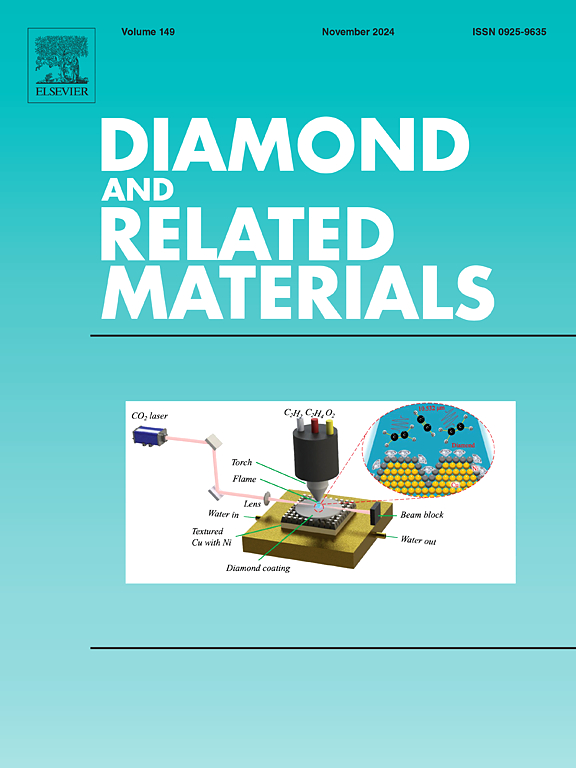Boosting electrochemical performance of FeCu(BDC) bimetallic MOF by incorporating optimized concentrations of MWCNTs for advanced supercapacitor applications
IF 4.3
3区 材料科学
Q2 MATERIALS SCIENCE, COATINGS & FILMS
引用次数: 0
Abstract
Bimetallic metal-organic frameworks (MOFs) are gaining significant attention as potential candidates for electrochemical energy storage applications due to their tunable composition, high porosity, and multiple active sites. In this study, FeCu(BDC) (BDC: benzene-1,4-dicarboxylic acid or terephthalic acid), a MOF synthesized using Fe and Cu metal ions with terephthalic acid as the organic linker, was composited with multi-walled carbon nanotubes (MWCNTs) at varying concentrations (0.5 %, 1.0 %, 1.5 %, and 2 %). Comprehensive structural, morphological, and surface area analyses were performed using XRD, FESEM, TEM, XPS, and BET techniques, confirming the successful formation of the composites. Electrochemical investigations revealed that the composite with 1 % MWCNT (FCMW1) exhibited the highest performance, achieving a specific capacitance of 1004.76 F g−1 at a scan rate of 2 mV s−1, measured via cyclic voltammetry. Additionally, the FCMW1 composite demonstrated an impressive energy density of 151.07 Wh kg−1 and a power density of 523.45 W kg−1 in a 1 M H₂SO₄ electrolyte. Electrochemical impedance spectroscopy (EIS) showed low charge transfer and solution resistance, highlighting the excellent conductivity of the composite. The enhanced performance of the composite is attributed to the synergistic interaction between the abundant active sites of FeCu(BDC) and the superior conductivity of MWCNTs. These results position FeCu(BDC)/MWCNT composites as promising materials for next-generation energy storage devices.
采用优化浓度的MWCNTs提高FeCu(BDC)双金属MOF的电化学性能
双金属金属有机框架(mof)由于其可调的成分、高孔隙率和多活性位点而成为电化学储能应用的潜在候选者,受到了广泛的关注。在本研究中,FeCu(BDC:苯-1,4-二羧酸或对苯二甲酸)是一种以Fe和Cu金属离子为原料,以对苯二甲酸为有机连接剂,与不同浓度(0.5%,1.0%,1.5%和2%)的多壁碳纳米管(MWCNTs)复合而成的MOF。利用XRD、FESEM、TEM、XPS和BET技术进行了全面的结构、形态和表面积分析,证实了复合材料的成功形成。电化学研究表明,含有1% MWCNT (FCMW1)的复合材料表现出最高的性能,在2 mV s−1的扫描速率下,通过循环伏安法测量的比电容达到1004.76 F g−1。此外,FCMW1复合材料在1 M H₂SO₄电解质中表现出令人印象深刻的能量密度151.07 Wh kg - 1和功率密度523.45 W kg - 1。电化学阻抗谱(EIS)显示该复合材料具有较低的电荷转移和溶液电阻,突出了其优异的导电性。复合材料性能的增强是由于FeCu(BDC)丰富的活性位点与MWCNTs优异的导电性之间的协同相互作用。这些结果表明FeCu(BDC)/MWCNT复合材料是下一代储能设备的有前途的材料。
本文章由计算机程序翻译,如有差异,请以英文原文为准。
求助全文
约1分钟内获得全文
求助全文
来源期刊

Diamond and Related Materials
工程技术-材料科学:综合
CiteScore
6.00
自引率
14.60%
发文量
702
审稿时长
2.1 months
期刊介绍:
DRM is a leading international journal that publishes new fundamental and applied research on all forms of diamond, the integration of diamond with other advanced materials and development of technologies exploiting diamond. The synthesis, characterization and processing of single crystal diamond, polycrystalline films, nanodiamond powders and heterostructures with other advanced materials are encouraged topics for technical and review articles. In addition to diamond, the journal publishes manuscripts on the synthesis, characterization and application of other related materials including diamond-like carbons, carbon nanotubes, graphene, and boron and carbon nitrides. Articles are sought on the chemical functionalization of diamond and related materials as well as their use in electrochemistry, energy storage and conversion, chemical and biological sensing, imaging, thermal management, photonic and quantum applications, electron emission and electronic devices.
The International Conference on Diamond and Carbon Materials has evolved into the largest and most well attended forum in the field of diamond, providing a forum to showcase the latest results in the science and technology of diamond and other carbon materials such as carbon nanotubes, graphene, and diamond-like carbon. Run annually in association with Diamond and Related Materials the conference provides junior and established researchers the opportunity to exchange the latest results ranging from fundamental physical and chemical concepts to applied research focusing on the next generation carbon-based devices.
 求助内容:
求助内容: 应助结果提醒方式:
应助结果提醒方式:


